Section contents:
Feature image. A selection of fruits, showcasing different types. Left to right: Berries (American pokeweed, Phytolacca americana); drupes (devil's club, Oplopanax horridus); aggregate of follicles (Aquilegia, columbine); multiple of achenes (American sycamore, Platanus occidentalis); multiple of achenes (Osage orange, Maclura pomifera). Credits: All images by E.J. Hermsen (DEAL).
Introduction
Fruits can provide important taxonomic, phylogenetic, life-history, and ecological information about fossil plants. While fruits may form a portion of a fossil flora that includes other organs (like leaves), fruit and seed fossils dominate some fossil plant deposits. Such fruit and seed floras are sometimes called carpofossil floras or carpofloras, from the Greek karpos (fruit). Some examples of important fossil fruit and seed deposits include the Eocene Clarno Nut Beds of Oregon, U.S.A. (see here); the Paleogene London Clay Flora, U.K. (see here); and the Miocene Brandon Lignite flora of Vermont, U.S.A. (see here).
A fruit is a structure surrounding or containing one or more seeds. True fruits are found only in flowering plants, because a fruit develops at least in part from the ovary of a flower. The ovary is the part of the flower that contains the ovules (immature seeds). The fruit wall is called a pericarp (from Greek peri + karpos = around fruit or Greek perikárpion = pod). Technically, the pericarp consists only of the portion of the fruit wall that develops from the ovary wall. Fruits frequently include structures that develop from floral parts located outside of the ovary as well. For example, fruit wings may develop from sepals, and fruit flesh may develop from a hypanthium (floral cup or floral tube).
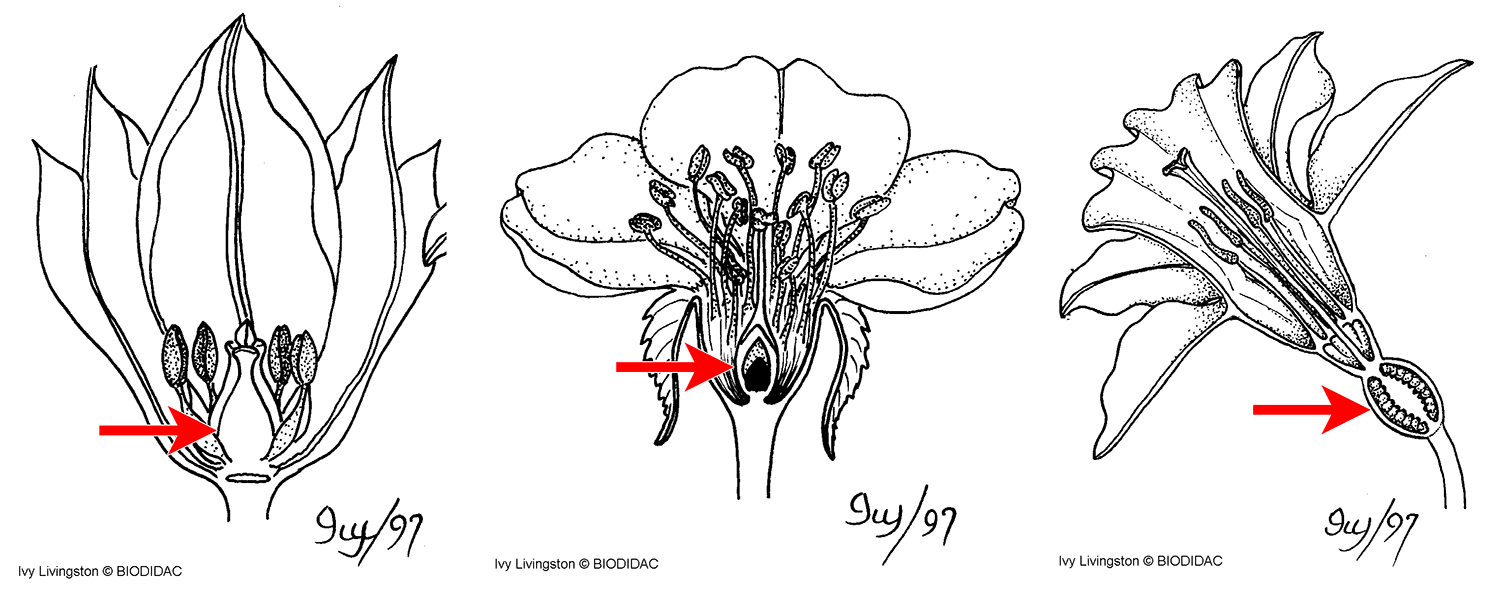
Location of the ovary. These drawings show flowers that each have a single pistil and a single ovary. On each drawing, the location of the ovary is indicated by a red arrow. Left: A hypogynous flower (superior ovary). Center: A perigynous flower (superior ovary surrounded by free hypanthium). Right: A epigynous flower (inferior ovary). Credits: Hypogynous flower, perigynous flower, and epigynous flower (Ivy Livingston, via BIODIDAC, CC BY-NC 4.0). Images modified from originals.
Flowering plants produce many different types of fruits. Typically, basic fruit classifications divide fruits into three major categories. These categories are based on the number of ovaries (pistils) and the number of flowers from which a fruit develops. These categories are as follows:
- Simple: a fruit from one ovary (pistil). The ovary may be made up of one carpel, or two or more fused carpels. (For more on carpels, see here.)
- Aggregate: a fruiting structure made up of a group of fruits produced by a single flower. An aggregate fruit develops from one flower that has more than one ovary (more than one pistil).
- Multiple: a fruiting structure made up of a group of fruits produced by more than one flower. A multiple fruit develops from ovaries of more than one flower.
Simple fruits are typically divided into fleshy types (i.e., those with a relatively soft wall) and dry types (i.e., those with a stony, fibrous, papery, or sometimes leathery wall). Dry types are further divided into dehiscent (opening to release the seeds) and indehiscent (not opening to release the seeds). Aggregate and multiple fruits can be understood as compound fruiting structures made up of groups of associated or fused simple fruits. Aggregate and multiple fruits sometimes include highly modified floral tissues that contribute significantly to their structure (as in the strawberry, the rose, and the mulberry, discussed below).
Common types of fruits are described with examples below. A brief discussion of fossil fruits can be found at the bottom of this page.
Simple, fleshy fruits
A simple, fleshy fruit develops from a single ovary (pistil). The ovary may be composed of one or more carpels. Simple, fleshy fruits are divided into three basic types: the berry, the pome, and the drupe.
Berries
A berry is a fruit with a fleshy pericarp (fruit wall). The exocarp (Greek exō = outer), or outer part of the fruit wall, is a thin skin or a leathery or hard rind. A berry may contain one or more seeds. Examples of berries are tomatoes (Solanum lycopersicum), peppers (Capsicum), grapes (Vitis), blueberries (Vaccinium), and bananas (Musa). Avocados (Persea americana) are large-seeded berries. Many fleshy fruits that we commonly call "berries"—such as raspberries and blackberries (Rubus), strawberries (Fragaria), and mulberries (Morus)—are not berries in a botanical sense. These so-called "berries" are discussed further below.
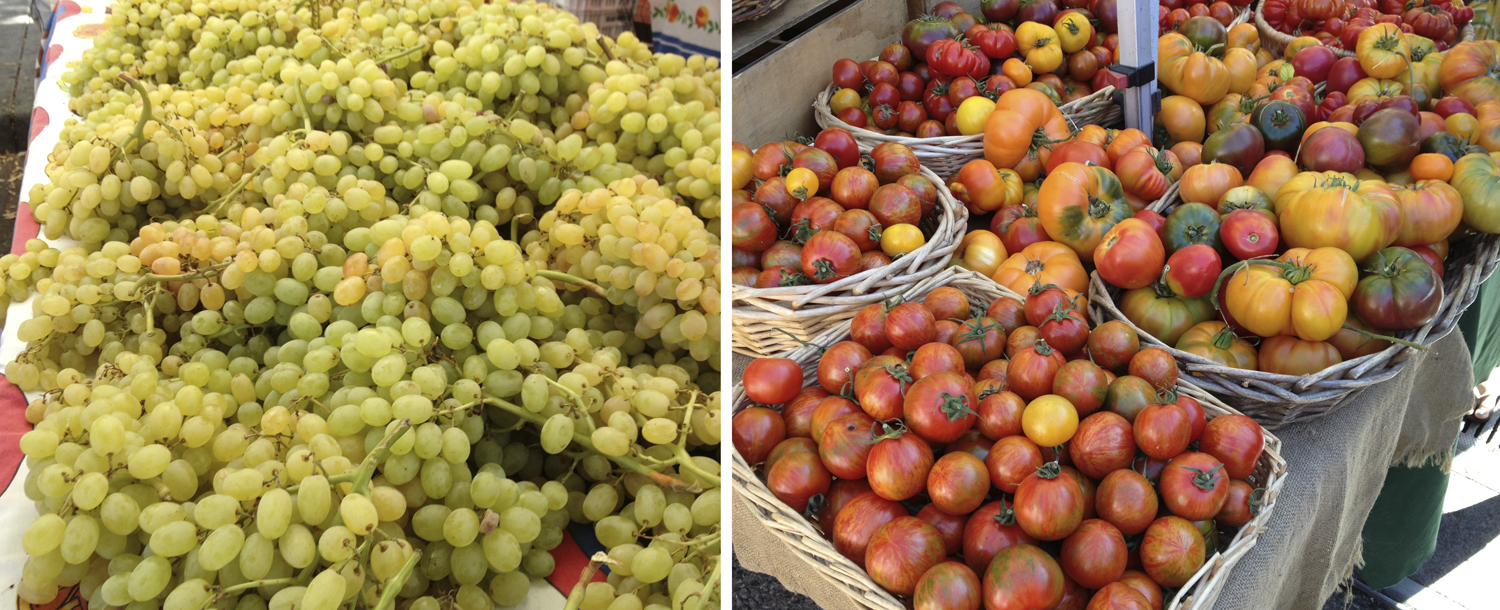
Berries. Left: Table grapes (Vitis vinifera). Right: Tomatoes (Solanum lycopersicum). Credits: Grape and tomatoes (J.R. Hendricks, DEAL).
Oranges and other citrus fruits (Citrus) are examples of a type of berry known as a hesperidium. The hesperidium is named after mythical nymphs called Hesperides (in Greek myth, the demigod Hercules has to retrieve golden apples—thought to be oranges by some—from the garden of the Hesperides). Hesperidia are covered by a leathery peel or rind; inside, they have partitions and "juice sacs," which are really modified plant hairs (trichomes).
Pepos (Greek, pepōn = gourd), another type of berry, are produced by some members of the gourd family (Cucurbitaceae). Pumpkins, squash, gourds, and zucchinis (Cucurbita spp.); cucumbers, cantaloupes, and various melons (Cucumis spp.); and watermelons (Citrullus lanatus) are examples of pepos. A pepo has a hard wall surrounding the softer interior of the fruit. Pepos have many seeds, sometimes in a soft pulp. The interior of the fruit has no partitions.
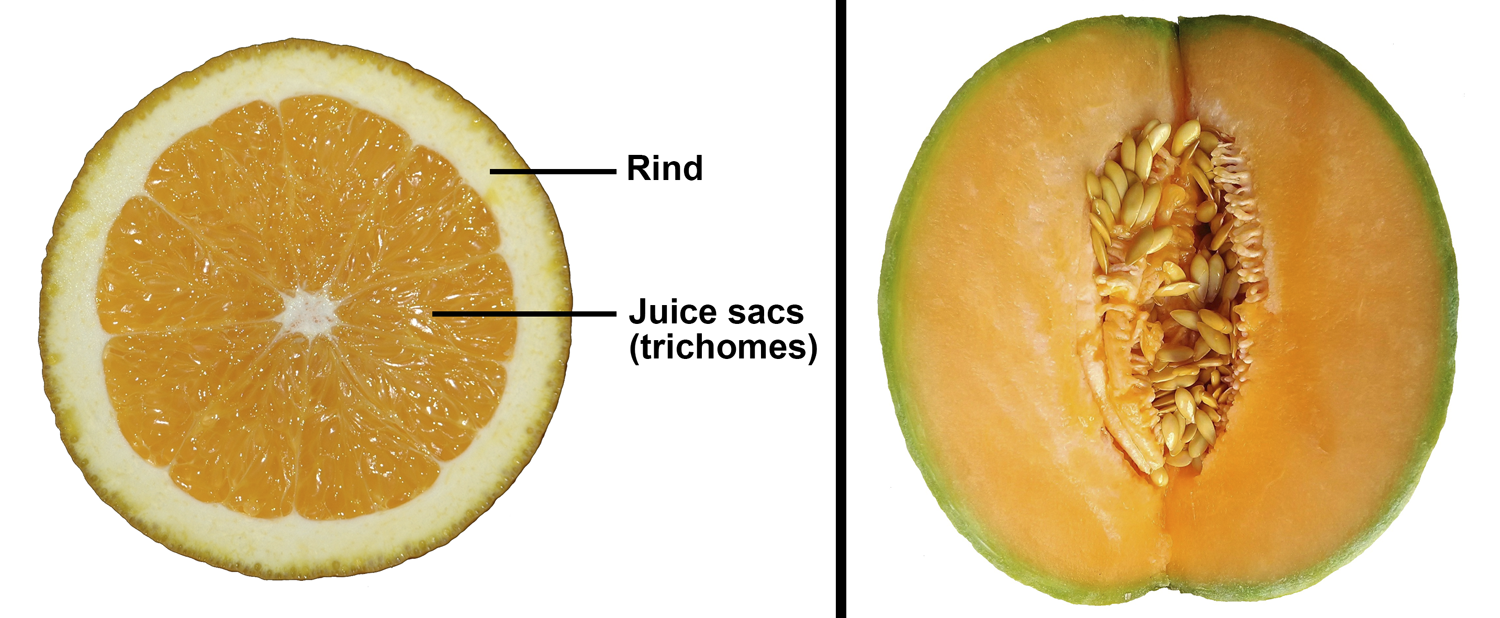
The hesperidium and the pepo, subtypes of berries. Left: An orange (Citrus sinensis), a hesperidium, in cross section showing the rind (outer layers of the fruit wall) and juice sacs. Right: A cantaloupe (Cucumis melo) in longitudinal section, showing the hard rind, fleshy interior, and pulpy center with many seeds. Credits: Orange (Ekko, via Wikimedia Commons, CC BY-SA 3.0); Cucumis melo (Filo gèn', via Wikimedia Commons, CC BY-SA 4.0). Images modified from originals.
Pomes
A pome is a berry-like fruit in which much of the flesh is accessory tissue, or fleshy tissue that develops from structures outside the ovary wall. These fruits have a core that contains the seeds. The core develops from the ovary proper. The top of the fruit may have remnants of floral parts (sepals, stamens, etc.), and the "stem" of the fruit is the flower stalk (pedicel). Thus, what we typically think of as the top of the fruit is actually the bottom.
Pomes are produced by some members of the rose family (Rosaceae). Examples are apples (Malus), pears (Pyrus), quince (Cydonia), loquat (Eriobotrya), medlar (Mespilus), hawthorn (Crataegus), serviceberry (Amelanchier), and rowan (Sorbus).
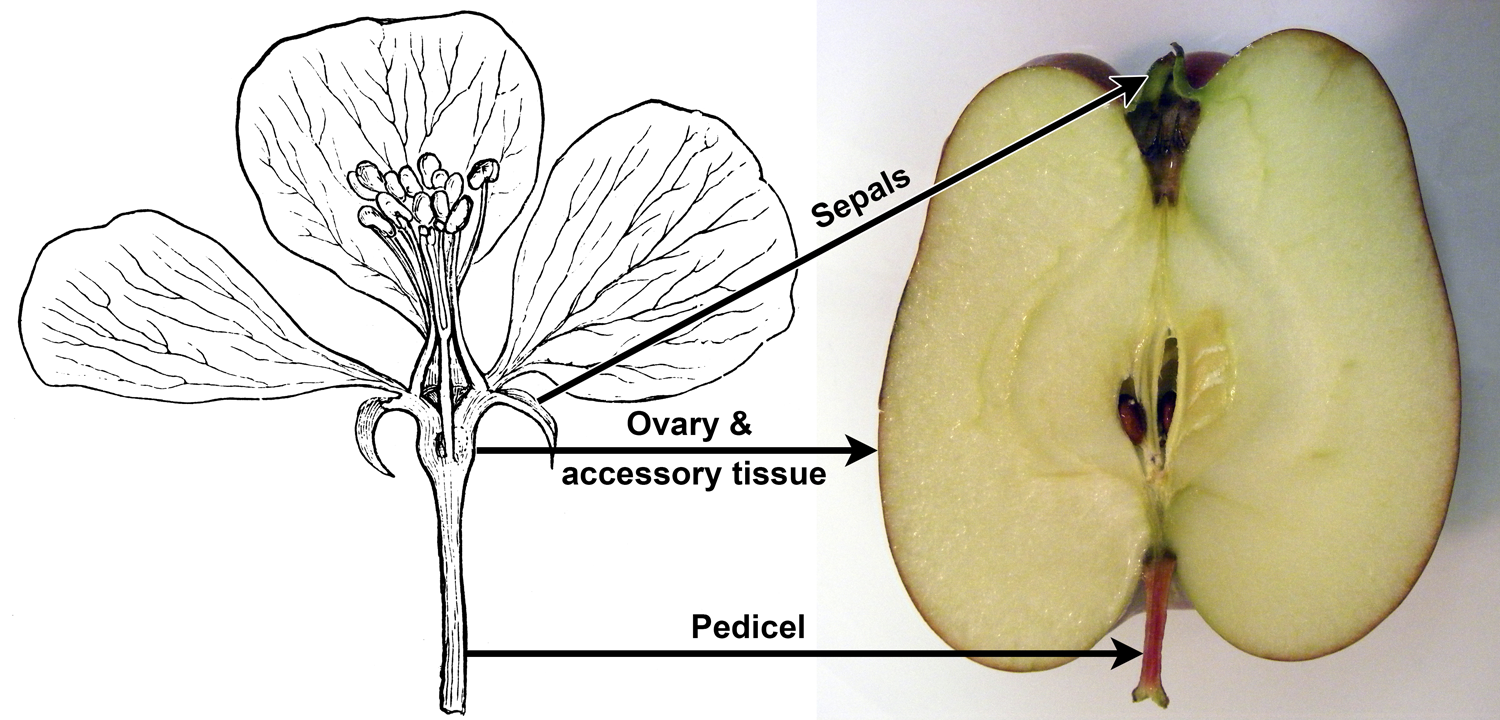
Structure of a pome. Structure of a pome, showing the corresponding parts of an apple flower and an apple fruit: sepals, the ovary and surrounding accessory tissue, and the pedicel (stalk). Credits: Apple blossom (from Yearbook of USDA 1898, via ClipArt ETC, license); red delicious half (J.smith, via Wikimedia Commons, CC BY-SA 3.0). Images modified from originals.
Drupes
Drupes are fleshy fruits with three easily distinguished wall layers. They are as follows:
- Exocarp: outer layer, often a thin skin (Greek exō + karpos = outer fruit).
- Mesocarp: the middle, fleshy part (Greek mesos + karpos = middle fruit). Sometimes the mesocarp is fibrous.
- Endocarp: hard inner layer that surrounds the seed or seeds (Greek endon + karpos = within fruit).
Drupes are sometimes called stone fruits, due to the hard "stone" in the center. This stone is also known as a pit (like the pit of a peach) or a pyrene.
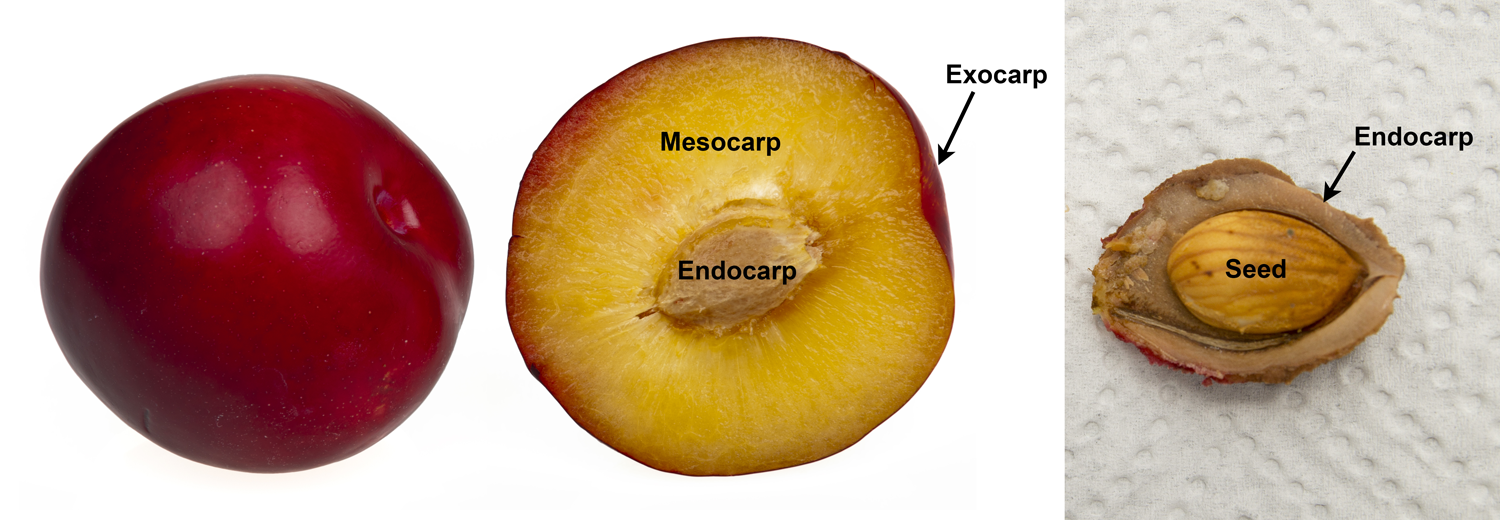
Structure of a drupe. Left: A whole plum (Prunus domestica). Center: A plum cut in half, showing the outer, skin-like exocarp, the fleshy mesocarp, and the endocarp surrounding the seed. Right: A peach (Prunus persica) pit opened to show the endocarp and seed inside. Credit: Red plums (Evan-Amos, via Wikimedia Commons, Public Domain); peach pit (An.ha, via Wikimedia Commons, CC BY-SA 3.0). Images modified from originals.
Fruits in the genus Prunus (Rosaceae, rose family) are drupes, including peaches, plums, apricots, pluots, cherries, and nectarines. In these fruits, we eat the exocarp and mesocarp, while throwing away the pit (the endocarp and the seed within it). Some so-called "nuts" come from drupes, like almonds (Prunus dulcis) and pistachios (Pistacia vera). We eat the seeds of these drupes, which are typically sold after the exocarp, mesocarp, and sometimes endocarp (the "nutshell") have been removed. Coconuts (Cocos nucifera) are drupes with a fibrous mesocarp. The mesocarp is often removed from fresh coconuts sold in grocery stores. The white coconut "meat" is the endosperm of the seed.
Simple, dry & dehiscent fruits
A dehiscent fruit opens at maturity to release its seeds. Common types of dehiscent fruits include follicles, legumes, and capsules.
Follicles & legumes
A follicle is a dehiscent fruit that develops from a single carpel. It opens, or dehisces, along one suture. A milkweed (Asclepias) "pod" is a good example of a follicle. Hellebore (Helleborus) and columbine (Aquilegia, at the top of this page) flowers produce groups of follicles, each developing from a separate carpel. The fruit of magnolia (Magnolia) is also made up of a group of follicles, which are all attached to the conical receptacle of a single flower. If a group of follicles develops from a single flower, the whole aggregate structure can be called a follicetum. (See more discussion under Aggregate fruits, below.)
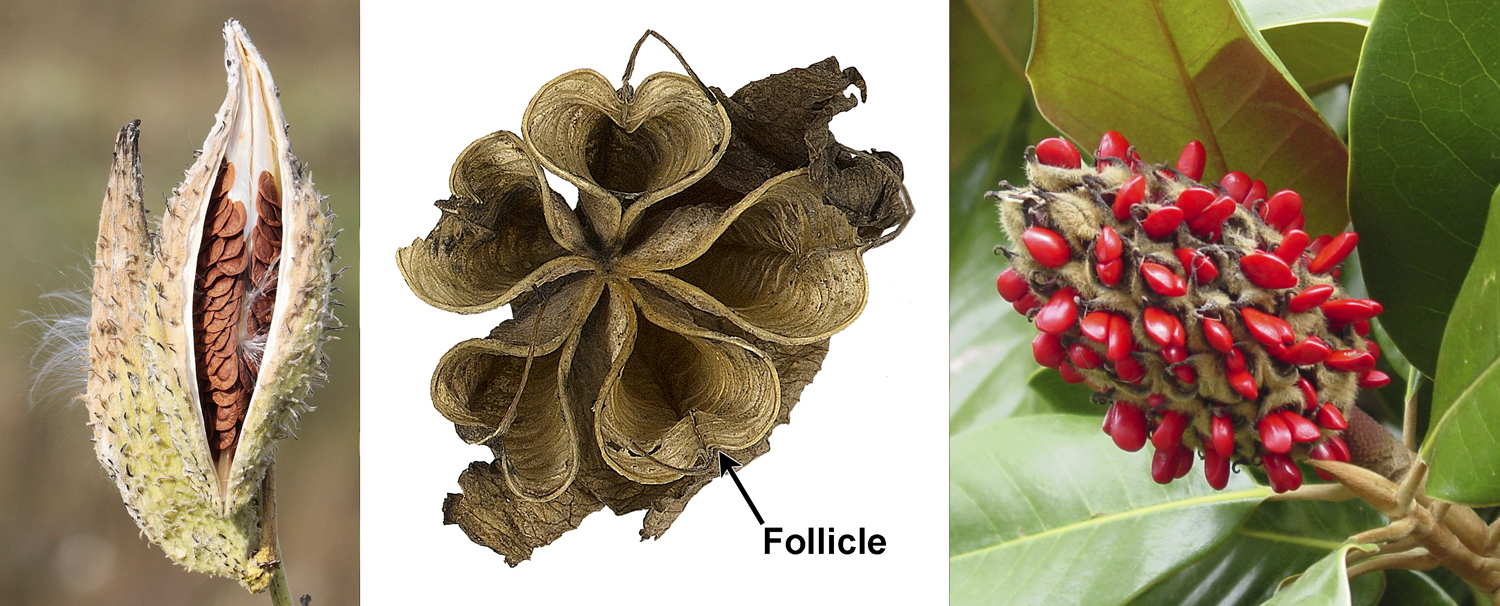
A legume is similar to a follicle. It is also a fruit that develops from a single carpel. At maturity, it opens along two sutures. Legumes are produced by many members of the legume family (Fabaceae—the term "legume" can be used to refer both to the type of plant and to the type of fruit). An example of a legume fruit that we eat whole is the green bean (Phaseolus vulgaris). Sugar peas and snow peas are immature legume fruits (pea pods) produced by the garden pea (Pisum sativa); edamame is the whole, immature fruit of the soybean (Glycine max).
In many edible legumes, we eat the seeds (called pulses if dried) that have been removed from the fruit. Green peas, chick peas, black-eyed peas, pinto beans, black beans, kidney beans, etc., are all seeds from legumes. Peanuts in the shell are indehsicent legume fruits, whereas the peanuts themselves are seeds. (Botanically speaking, peanuts are not classified as nuts!)

Legumes. Left: Japanese wisteria (Wisteria floribunda), open fruit with seeds. Right: Narrowleaf lupine (Lupinus angustifolius) fruits and seeds. Credits: Wisteria floribunda and Lupinus angustifolius (Roger Culos, via Wikimedia Commons, CC BY-SA 3.0). Images modified from originals.
Capsules & capsule-like fruits
A capsule is a dehiscent fruit that is formed from two or more fused carpels. Capsules have many methods of opening. Often, they open by slits or valves; however, they can open by lids, pores, or other methods. Many flowering plants produce capsules. Examples include cotton (Gossypium) and poppies (Papaver). While capsules are considered to be dry fruits, they vary in texture. Often, they are woody, papery, or fibrous. However, they can be thick and leathery, as in the buckeyes and horse chestnuts (Aesculus), or inflated, as in the bladdernut (Staphylea).
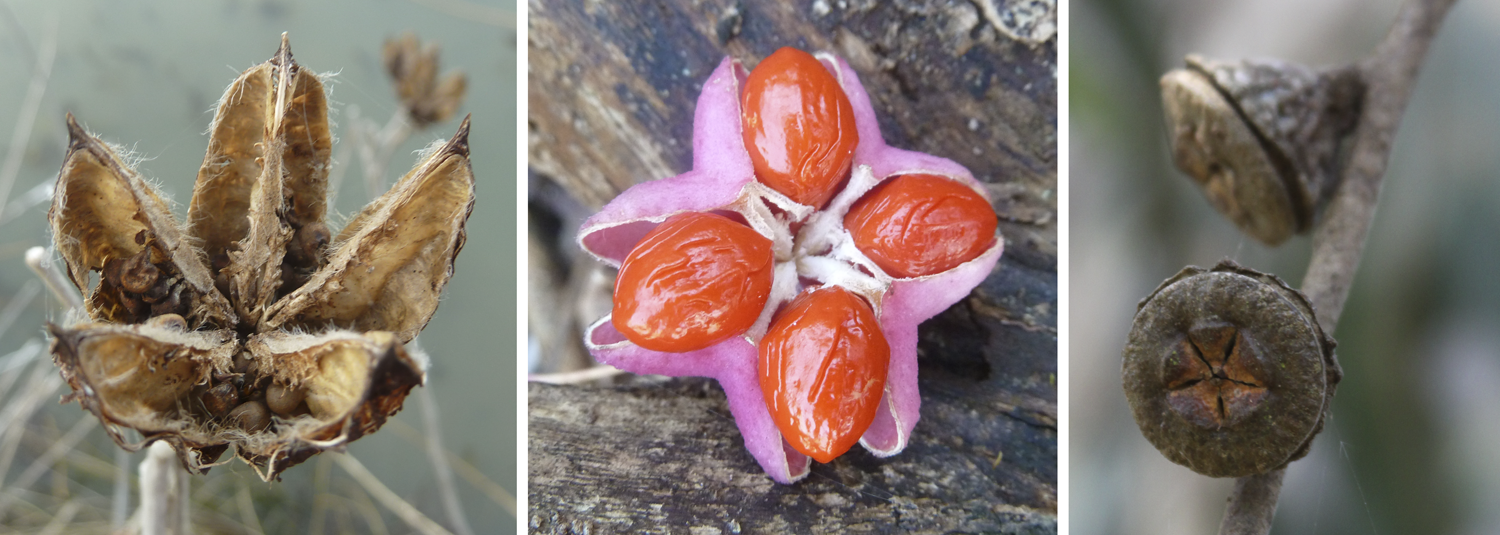
Capsules. Left: Open capusule of crimson-eyed rosemallow (Hibiscus moscheutos). Center: Eastern wahoo (Euonymous atropurpureus), a pink capsule open to show four seeds with fleshy red arils. Right: Closed capsule of blue gum (Eucalyptus globulus). Credits: Hibiscus moscheutos and Euonymous atropurpureus (E.J. Hermsen, DEAL); Eucalyptus globulus (J.R. Hendricks, DEAL).
Siliques and silicles are capsule-like fruits characteristic of the mustard family (Brassicaceae). This type of fruit develops from an ovary of two, fused carpels. When mature, the outer wall of the fruit breaks away as two valves, leaving a replum (septum or membrane) to which the seeds are attached. The difference between the terms "silique" and "silicle" has to do with how elongated the fruit is, with siliques being more elongated than silicles.
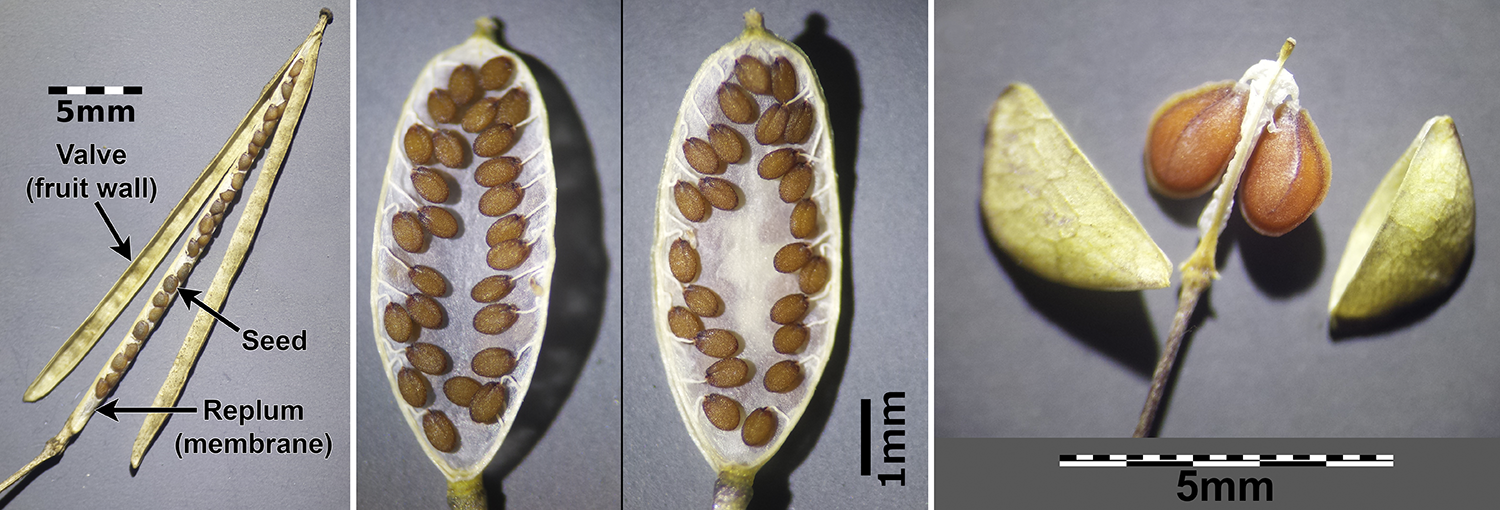
Siliques and silicles. Left: Silique of perennial wall-rocket (Diplotaxis tenuifolia), showing outer valves, replum, and seeds. Center: Silique of spring draba (Draba verna), with valves removed to show the seeds attached to the replum. Right: Silicle of clasping pepperweed (Lepidium perfoliatum) with valves removed to expose the seeds attached to the replum. Credits: Diplotaxis tenuifolia, Draba verna, and Lepidium perfoliatum (Stefan.Iefnaer, via Wikimedia Commons, CC BY-SA 4.0). Images modified from originals.
Simple, dry & indehiscent fruits
Dry, indehiscent fruits are dry fruits that do not open to release their seeds at maturity. Examples include achenes, grains, nuts, and schizocarps.
Achenes & achene-like fruits
An achene is a fruit with a dry pericarp that does not open. An achene contains a single seed, which is mostly free from the fruit wall. Members of the aster family (Asteraceae) produce an achene-like fruit that is sometimes called a cypsela. A cypsela develops from an inferior ovary made up of two fused carpels. (Note that many sources accept the use of the term "achene" for the fruit of the aster family.)
A samara is a winged achene or achene-like fruit. The wing of a samara forms as an outgrowth of the ovary wall (in other words, it is part of the pericarp). Elms (Ulmus) produce samaras, and the term "samara" is from the Latin word for an elm seed.

Achenes and achene-like fruits. Left: Aggregates of achenes in clematis (Clematis); each cluster of achenes develops from the pistils of a single flower. Center: Sunflower "seeds," really the fruits (cypselae) of the sunflower (Helianthus annuus). Right: Samaras of an elm (Ulmus). Credits: Clematis (E.J. Hermsen, DEAL); Helianthus annuus (Amada44, via Wikimedia Commons, CC BY 3.0); Ulmus (J.R. Hendricks, DEAL).
Caryopses (grains)
A grain or caryopsis is a single-seeded fruit found in members of the grass family (Poaceae), such as barley (Hordeum vulgare), corn (Zea mays), oats (Avena sativa), rice (Oryza sativa), and wheat (Triticum). It looks like an achene, but the seed is fully fused to the fruit wall. The fruit wall may be very thin and not easily distinguished from the seed coat.
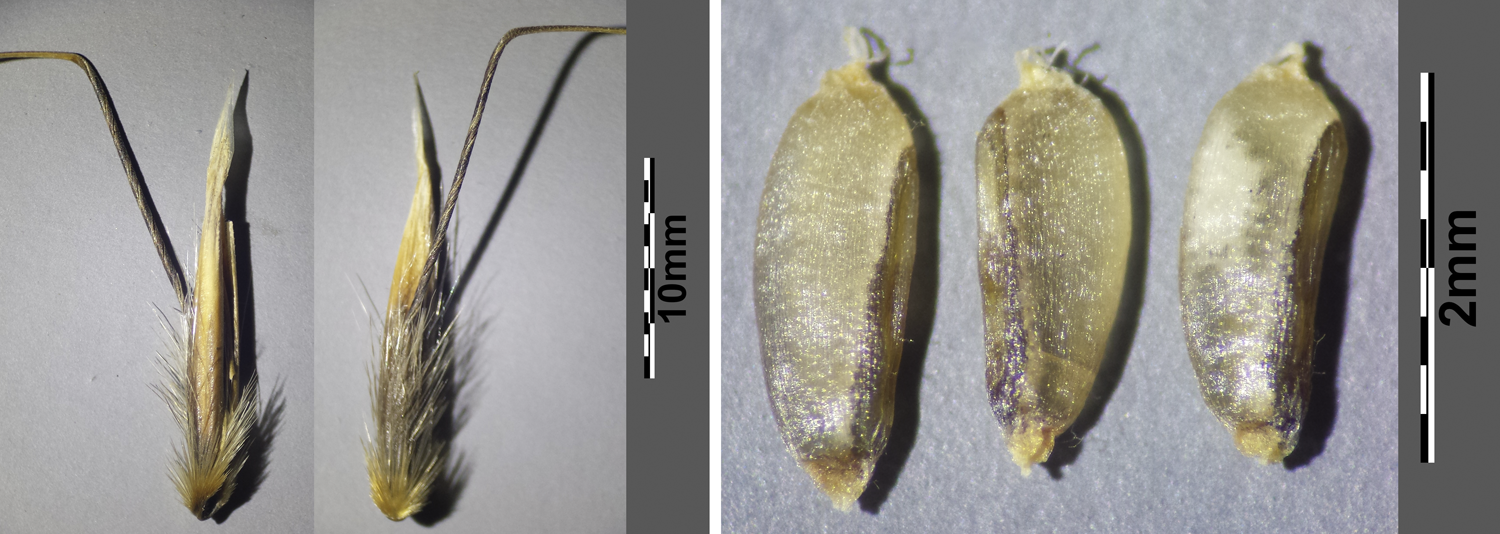
Caryopses. Left: Common wild oat (Avena fatua) caryopses and associated structures. Right: Pricklegrass (Crypsis aculeata) caryopses. Credits: Avena fatua and Crypsis aculeata (Stefan.Iefnaer, Wikimedia Commons, CC BY-SA 4.0). Images modified from originals.
Nuts
A nut is a single-seeded fruit with a hard pericarp (the nutshell). A nut typically develops from an ovary with a single interior chamber, although it may be made up of more than one carpel. Acorns (the fruit of an oak, Quercus) are nuts. Other examples of nuts include hazelnuts (Corylus) and chestnuts (Castanea).
Associated structures may partially or fully envelope a nut. For example, the cupule is a cap or envelope around nuts in plants of the beech family (Fagaceae), including oak acorns and chestnuts. Other nuts, like those of the birch family (Betulaceae) may be surrounded by leafy bracts.

Nuts. Left: Acorns of a white oak (Quercus alba), one with a cupule (cap). Center: Sweet chestnuts (Castanea sativa) in a prickly cupule. Right: Nuts of common hazel (Corylus avellana), each of which is associated with leaf-like bracts. Credits: Quercus alba acorns (Steve Hurst, hosted by USDA-NRCS PLANTS Database, no copyright); fruit of sweet chestnut (Benjamin Gimmel, via Wikimedia Commons, CC BY-SA 3.0); Corylus avellana (H. Zell, via Wikimedia Commons, CC BY-SA 3.0). Images modified from originals.
Walnuts (Juglans) and hickories (Carya, which includes Carya illinoinense, the pecan) produce drupe-like fruits consisting of a nut enclosed in a husk. The husk does not develop from the ovary wall, but is an accessory structure that develops from tissue outside of the ovary wall (see here). The nut and surrounding husk together are sometimes called a pseudodrupe (Greek pseudēs = fake) or tryma. In hickories, the husk is dehiscent, splitting open when the fruit is mature.
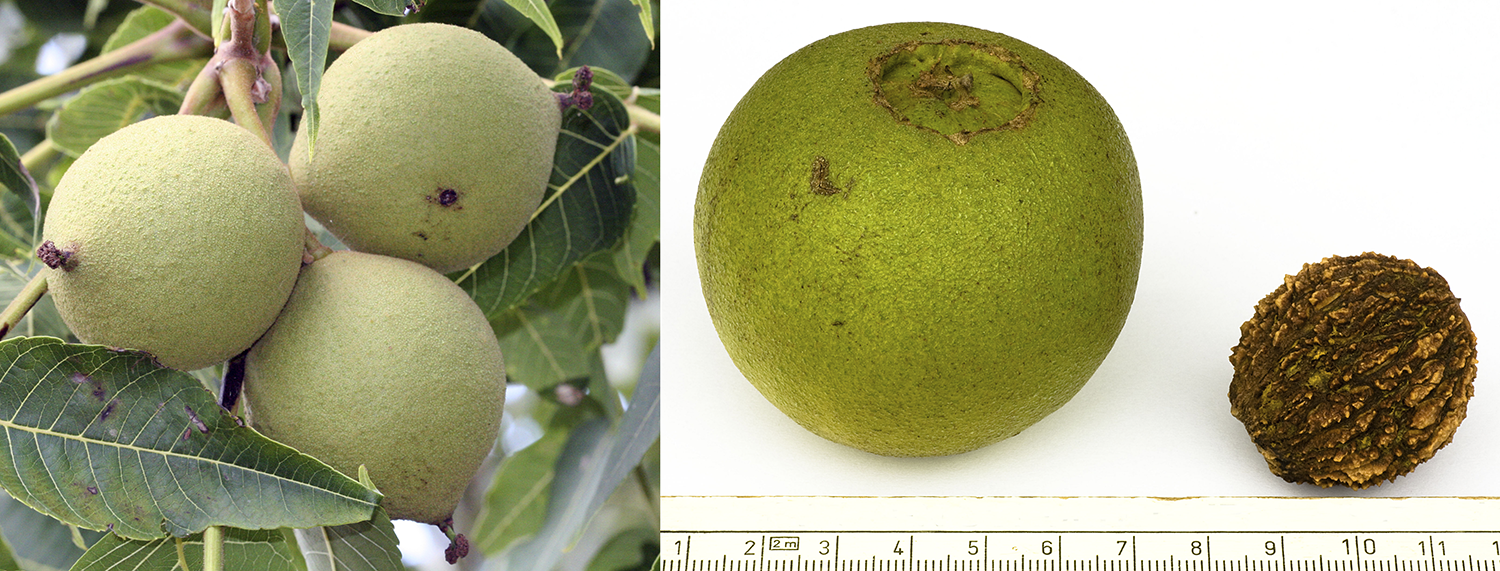
Walnuts. Left: Black walnuts (Juglans nigra) with intact husks. The stigmas of the flowers can still be seen at the apex of each fruit. Right: Whole walnut fruit next to a walnut that has had its husk removed. Credits: Juglans nigra (R.A. Nonenmacher, via Wikimedia Commons, CC BY-SA 4.0); Black walnut fruit (Gero Brandenburg, via Wikimedia Commons, CC BY-SA 3.0 DE). Images modified from originals.
Schizocarps & schizocarp-like fruits
Schizocarps (Greek, schizein + karpos = split fruit) are fruits that break apart into indehiscent, often one-seeded units called mericarps (Greek, meris + karpos = part fruit). Schizocarps develop from flowers with two or more fused carpels, with each carpel forming a mericarp. Schizocarps are produced by, for example, members of the parsley family (Apiaceae, including Conium maculatum shown below), the musk mallow (Malva moschata), and maples (Acer). The individual mericarps of maples look like samaras; thus, the fruit of a maple is sometimes called a samaroid (samara-like) schizocarp or double samara.
In some schizocarp-like fruits, each carpel may split into more than one one-seeded unit. For example, in the mint family (Lamiceae, including Stachys sylvatica shown below), flowers have two carpels. At maturity, each carpel produces two one-seeded nutlets (little nuts). Thus, there are four nutlets per flower.

Schizocarps and nutlets. Left: Schizocarps of poison hemlock (Conium maculatum); note that each splits into two mericarps. Center: Samaroid (samara-like) schizocarp of sugar maple (Acer saccharum) made up of two winged mericarps. Right: Nutlets of hedge woundwort (Stachys sylvatica). Credits: Conium maculatum (Doug Goldman, hosted by USDA-NRCS PLANTS Database, no copyright); Acer saccharum (Steve Hurst, hosted by USDA-NRCS PLANTS Database, no copyright); Stachys sylvatica (Vojtěch Zavadil, via Wikimedia Commons, CC BY-SA 3.0). Images modified from originals.
Some members of the legume family (Fabaceae) produce a type of fruit called a loment. Like a legume (described above under dry, dehiscent fruits), a loment develops from a single carpel. However, a loment breaks apart at constrictions between each seed rather than splitting open to release its seeds.
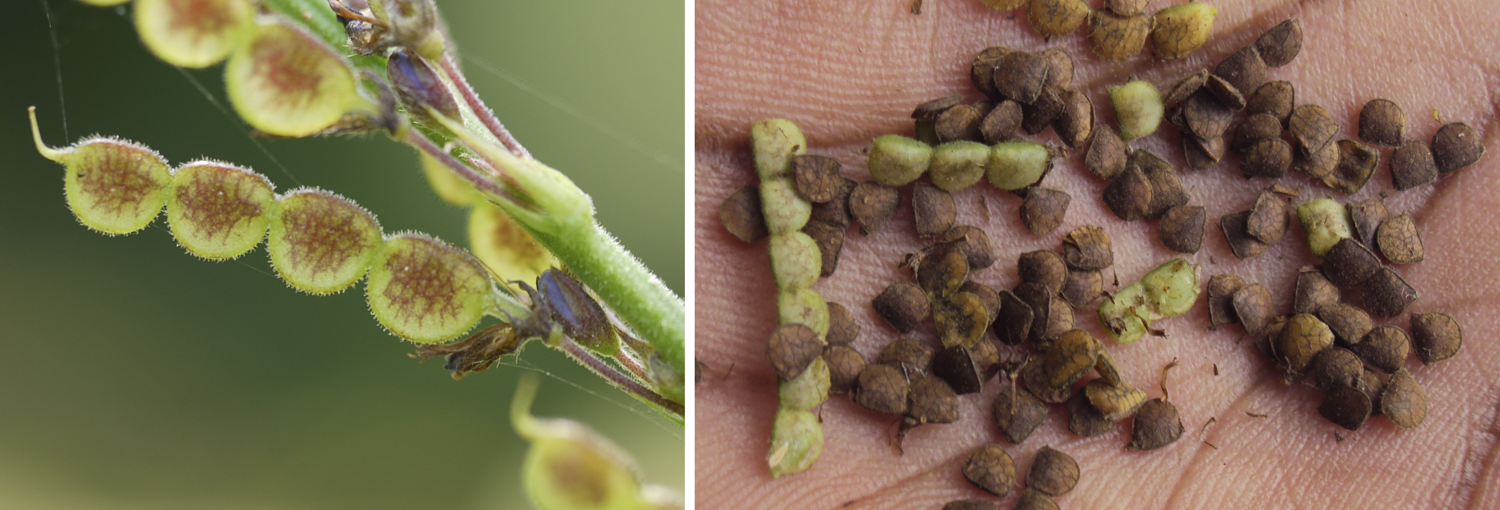
Loments. Left: A loment of tick-trefoil (Desmodium), showing constrictions between each seed. Right: At maturity, the loment breaks apart at the constrictions; each segment contains one seed. Credits: Desmodium gangeticum, Dhruva (Dinesh Valke, via Wikimedia Commons, CC BY-SA 2.0); Desmodium gangeticum (Vinayaraj, via Wikimedia Commons, CC BY-SA 3.0). Images modified from originals.
Aggregate fruits
An aggregate fruit is a fruiting structure made up of a group of fruits produced by a single flower. Thus, an aggregate fruit develops from a flower with more than ovary (more than one pistil). The compound structure of an aggregate fruit is often apparent to the observer, because the individual ovaries/pistils are often at least somewhat discernable in the mature fruit.
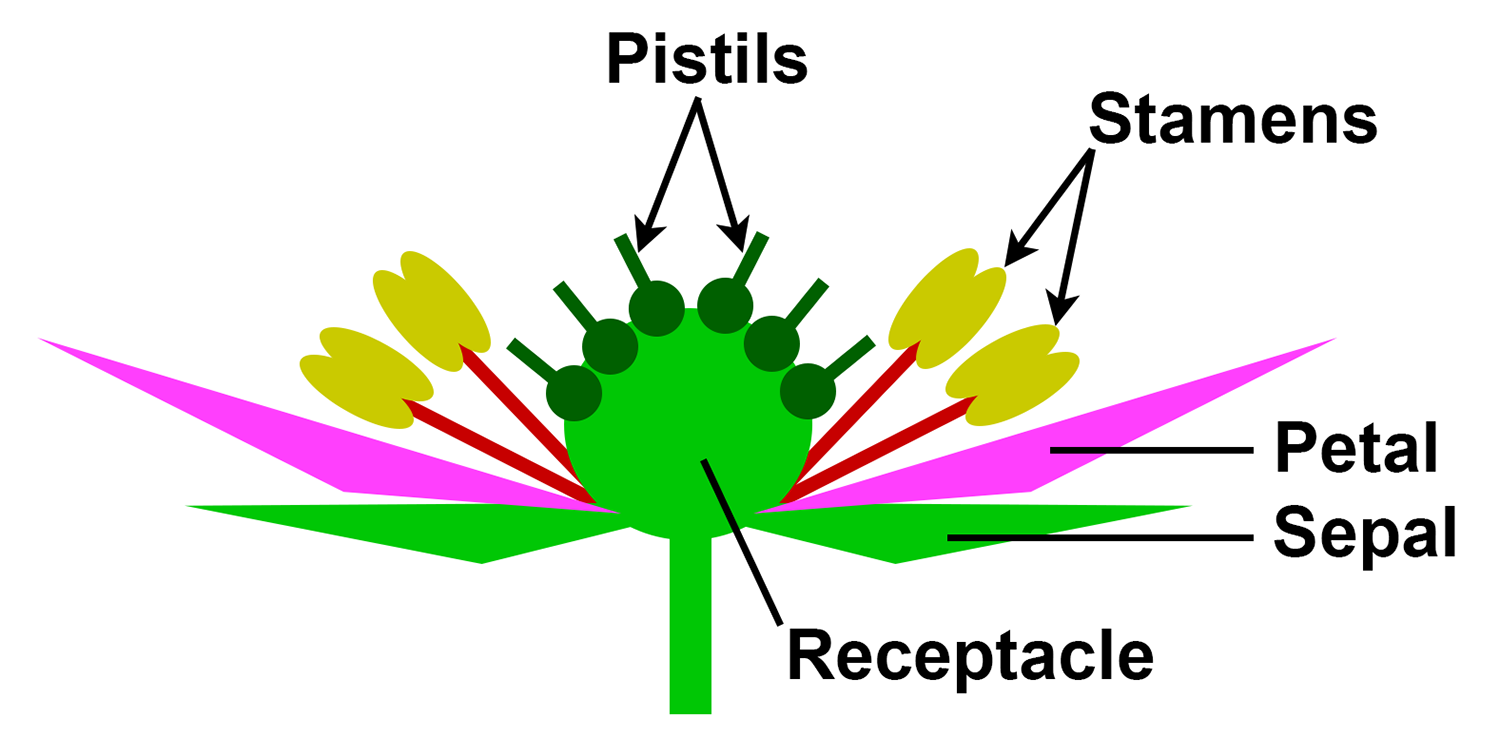
Structure of a flower with an several pistils. This diagram is a simplified reconstruction of a longitudinal section of a flower with more than one pistil (i.e., an apocarpous gynoecium), similar to a strawberry (Fragaria) or raspberry (Rubus) flower. Each pistil will develop into a fruit/fruitlet that makes up a part of an aggregate fruit. Credit: E.J. Hermsen (DEAL).
Aggregate fruits are diverse in their structures and specialized vocabulary has been proposed to describe them. For example, an aggregate made up of follicles can be called a follicetum, whereas an aggregate made up of drupelets (little drupes) can be called a drupecetum. A simpler way to describe them is as an "aggregate of [fruit type]." Thus, a Magnolia fruit (shown above under "Follicles & legumes") can be described as either a follicetum or as an aggregate of follicles. A blackberry fruit (discussed below) can be described as either a drupecetum or as an aggregate of drupelets. Using the simplified nomenclature "aggregate of [fruit type]" reduces the amount of jargon to learn (always a good thing, right?).
Aggregates in the Rose Family (Rosaceae)
To provide some examples of the structural diversity of aggregate fruits, let's take a look at some examples of familiar fruits from one plant family, the rose family (Rosaceae). Rubus (blackberries, raspberries, cloudberries, dewberries, loganberries, etc.) are not berries at all, but aggregate fruits made of tiny drupes, or druplets. The "seeds" of these fruits are actually tiny pyrenes, each consisting of an endocarp that surrounds a seed. The individual pistils are clearly visible in the mature fruits. As in the apple, the end that we tend to think of as the leafy top of the fruit is really the bottom. The "leaves" are the sepals, or calyx.
Strawberries are also not berries! The strawberry (Fragaria) flower is similar to the flower of the blackberry (Rubus) in structure. In the strawberry, however, the receptacle enlarges and becomes red, fleshy, and sweet. The "seeds" on the surface of the strawberry are really tiny achenes, each of which develops from a separate pistil. Thus, the strawberry is an aggregate of achenes. The leafy strawberry "tops" are the sepals that actually occur at the base of the flower. Can you find another aggregate of achenes on this page? (Hint: Search above.)

Structure of blackberry and strawberry fruits. Left: Mature blackberry (Rubus) fruit, showing the druplets, each of which developed from a separate pistil (the treadlike structures projecting from the druplets are styles). Center: A longitudinal section of a blackberry, showing the receptacle and the stone (endocarp and seed) within each drupelet. Right: Strawberries, showing the fleshy red receptacle covered by seed-like achenes. Credits: Rubus fruit and Rubus fruit long section (Frank Vincentz, via Wikimedia Commons, CC BY-SA 3.0); strawberry cross section (Prathyush Thomas, via Wikimedia Commons, GFDL). Images modified for DEAL.
Rose hips (also called heps or haws) are a type of aggregate fruit produced by roses (Rosa). A rose flower is perigynous. It has a floral cup, or hypanthium. Inside the hypanthium are multiple pistils. In fruit, it is the hypanthium that becomes fleshy and red; the individual pistils inside form achenes.
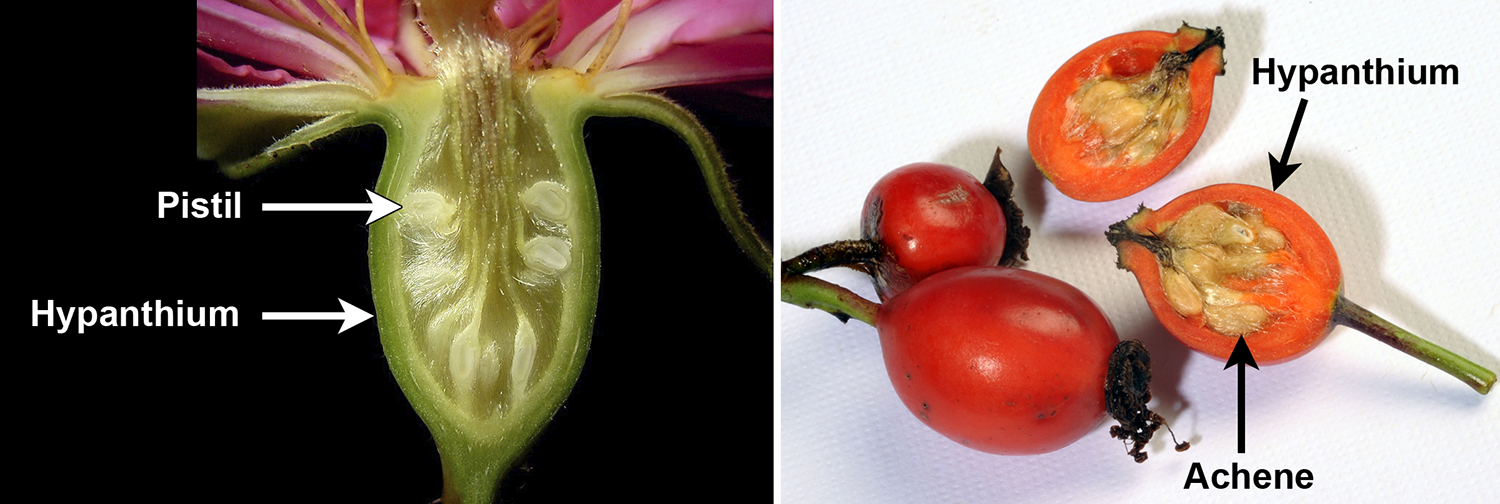
Structure of a rose hip. Right: Longitudinal section of a rose (Rosa) flower showing the hypanthium (floral cup), which contains many pistils. Right: Whole rose fruits and fruit sliced longitudinally to show the fleshy red hypanthium that contains achenes. Credits: rose flower (Frank Vincentz, via Wikimedia Commons, CC BY-SA 3.0); rose hips (Kotoviski, via Wikimedia Commons, CC BY-SA 3.0). Images modified from originals.
Multiple fruits
A multiple fruit is a fruiting structure that develops from the ovaries of more than one flower. In other words, a multiple fruit develops from an inflorescence (group of flowers). For many people, the most familiar example of a multiple fruit is the pineapple (Ananas cosmosus). Members of the mulberry family (Moraceae) also have multiple fruits. Examples include mulberries (Morus), figs (Ficus), Osage orange (Maclura pomifera), breadfruit (Artocarpus altilis), and jackfruit (Artocarpus heterophyllus).
Multiple fruits can be described using specialized terminology or as a "multiple of [fruit type]." In the mulberry (Morus, shown below), the fruit is considered to be a multiple of achenes. This description may seem counterintuitive, because the mulberry is fleshy, not dry. However, the flesh of the mulberry comes from the calyces (sepals) of the flowers and not the ovary walls. The Osage orange (Maclura pomifera) shown on the top of this page has a structure similar to that of the mulberry; it is also a multiple of achenes. Can you find another multiple of achenes on this page?
Notably, multiple fruits can look similar to aggregate fruits at maturity. In order to determine whether a fruit is an aggregate or a multiple, it may be necessary to trace its development from flower or inflorescence to fruit.
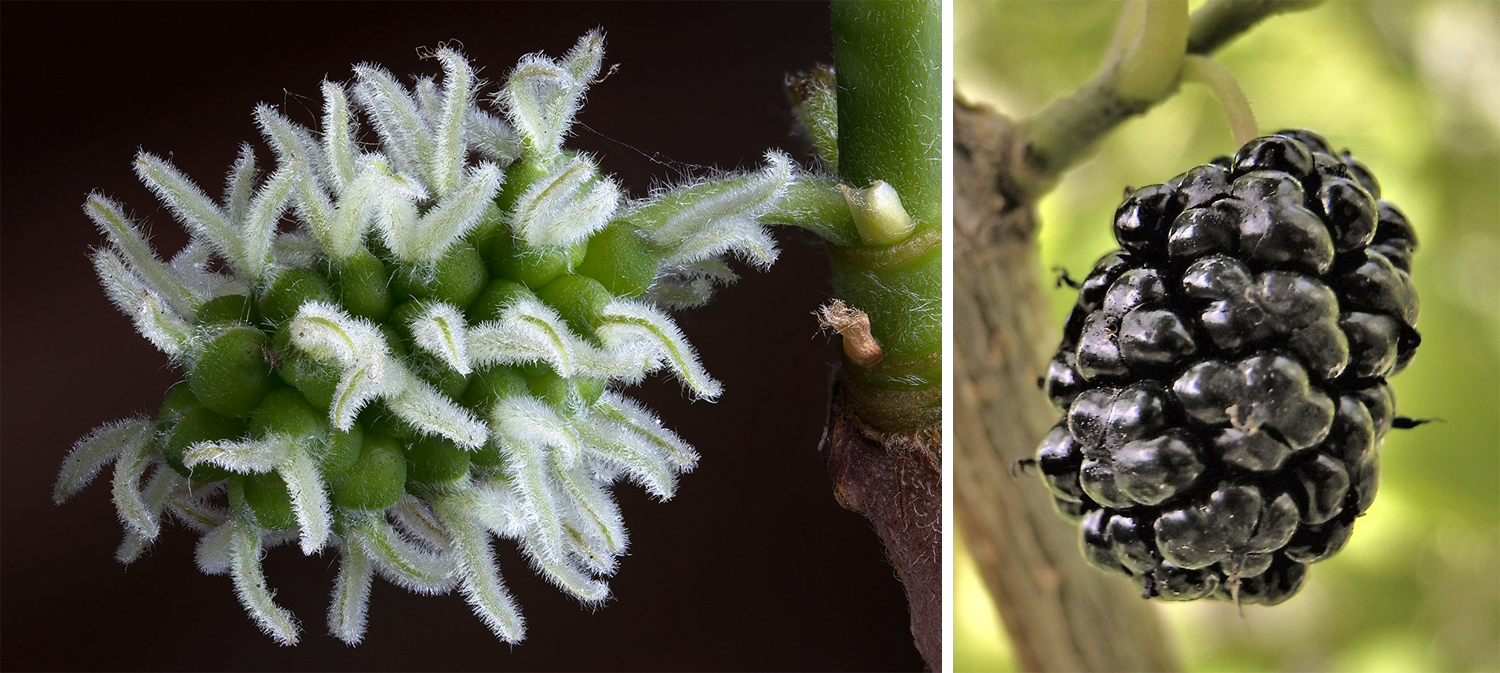
Mulberry (Morus) flowers and multiple fruit. Left: Pistillate inflorescence (group of female flowers) of black mulberry (Morus nigra); the white, feathery structures are stigmas. Right: Black mulberry fruit. Each unit of the fruit comes from a different flower, and consists of an achene surrounded by a fleshy calyx. Credits: Mulberry female flowers (JJ Harrison, via Wikimedia Commons, CC BY-SA 3.0); black mulberry fruit (Beko, via Wikimedia Commons, CC BY-SA 4.0). Images modified for DEAL.
Accessory fruits
Often, tissue from outside of the ovary wall (accessory tissue) contributes to the structure of a fruit. If tissue from outside of the ovary wall makes up a significant part of the fruit, the fruit is called an accessory fruit or, in some cases, a pseudocarp (Greek, pseudēs + karpos = fake fruit). Some of the fruits discussed above are accessory fruits. For example, apples, strawberries, rose hips, and mulberries are accessory fruits because the fruit flesh develops partially or entirely from structures outside of the ovary wall, such as the floral receptacle or the perianth.
Hypocarps
Cashews (Anacardium occidentale) are extremely weird fruits. Cashews grow on trees. On the tree, the fruit looks like an apple with a little kidney-shaped structure on the top. The "apple" is actually an enlarged, fleshy pedicel called a hypocarp (Greek, hypo + karpos = below fruit); the hypocarp does not contain seeds. The kidney-shaped structure on the top of the hypocarp is a drupe that contains a seed, or cashew "nut." Cashews are in the same plant family as poison ivy (Rhus toxicodendron). Many members of this family have compounds in their tissues that can irritate human skin. This includes the tissue surrounding the cashew seed. In tropical countries where cashews are grown, the cashew apples are eaten or used to make beverages.

Cashews. Left: Cashew (Anarcardium occidentale) fruits in a tree. Right: Comparison of whole cashew fruit and cashew fruit with hypocarp ("apple") cut longitudinally; the kidney-shaped structure at the top of the fruit is a drupe with the cashew seed ("nut") inside. Credits: Cashew nuts hanging on cashew tree (Vinayaraj, via Wikimedia Commons, CC BY-SA 3.0); cashew fruit and cashew fruit cut (Eric Gaba/Sting, via Wikimedia Commons, CC BY-SA 3.0). Images modified for DEAL.
Preservation of fruits in the fossil record
Fossil fruits can be found preserved in many different ways, such as compressions, molds, casts, permineralizations, or as lightly altered to unaltered remains (learn about types of fossil preservation here). The fossil fruit record is biased toward dry, woody, papery, or fibrous structures, whereas fleshy fruits or fruit structures are less often preserved. Grapes (Vitis), for example, produce berries with distinctive seeds. The seeds are often found in the fossil record, whereas the fleshy fruits themselves are not. Fleshy structures are sometimes preserved as permineralizations or compressions, particularly from localities known for exceptional preservation. For example, fossil cashews with attached hypocarps were found in the Eocene Messel Shale Laggerstätte of Germany (see here)!
Dry fruits without fleshy appendages like capsules, achenes, legumes, nuts, and samaras are most likely to be preserved whole. The walnut family (Juglandaceae), for example, has a good fossil fruit record because the diversity of hard, dry nuts and winged nutlets produced by members of the family tend to preserve well. In husk-covered nuts like hickories (Carya) and walnuts (Juglans), however, the husk is often missing.

Samaroid mericarps of Ailanthus. A samaroid mericarp is winged section of a schizocarp; see the fruit of maple (Acer), shown above, for comparison. Left: Modern samaroid mericarp of tree-of-heaven (Ailanthus altissima). Right: Compression of an Ailanthus americana samaroid mericarp (Eocene, Renova Formation, Montana, U.S.A. Scale bar in mm). Credits: Ailanthus altissima (Steve Hurst, hosted by USDA-NRCS PLANTS Database, no copyright); Ailanthus americana YPM PB 029443 (YPM-Yale Peabody Museum of Natural History, via GBIF, CC0 1.0).
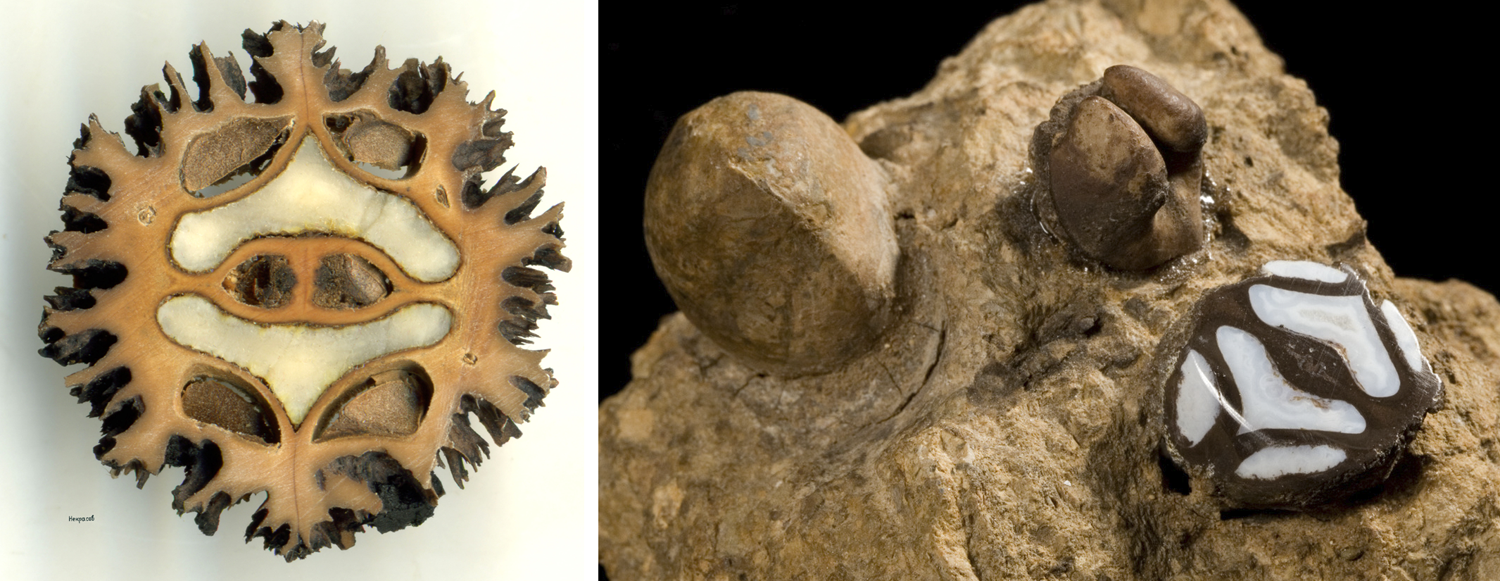
Juglans nuts. Left: Cross-section of a modern butternut (Juglans cinerea), showing locules filled with seed tissue and lacunae (open spaces in the center and periphery of the fruit wall). For photos of whole walnuts, see above on this page. Right: Fossil walnuts (Juglans clarnensis, Eocene, Clarno Formation, Oregon, U.S.A.); the specimen on the lower right side is in transverse section and shows locules and lacunae comparable to the modern specimen on the left. Credits: Juglans cinerea (Nekrasov, via Wikimedia Commons, CC BY-SA 3.0); Juglans clarnensis YPM PB 035771 (YPM-Yale Peabody Museum of Natural History, via GBIF, CC0 1.0). Images modified from originals.
Drupes have both hard parts (endocarps) and parts that are often fleshy or soft (mesocarps and exocarps). Thus, their endocarps are frequently preserved, whereas fleshy parts of the fruit are not. For example, a fossil peach (shown below) was described based solely on its pits (see here). Endocarps sometimes have ornamentation or other features that are taxonomically or phylogenetically important; these characteristics are useful for identifying endocarps in the fossil record.
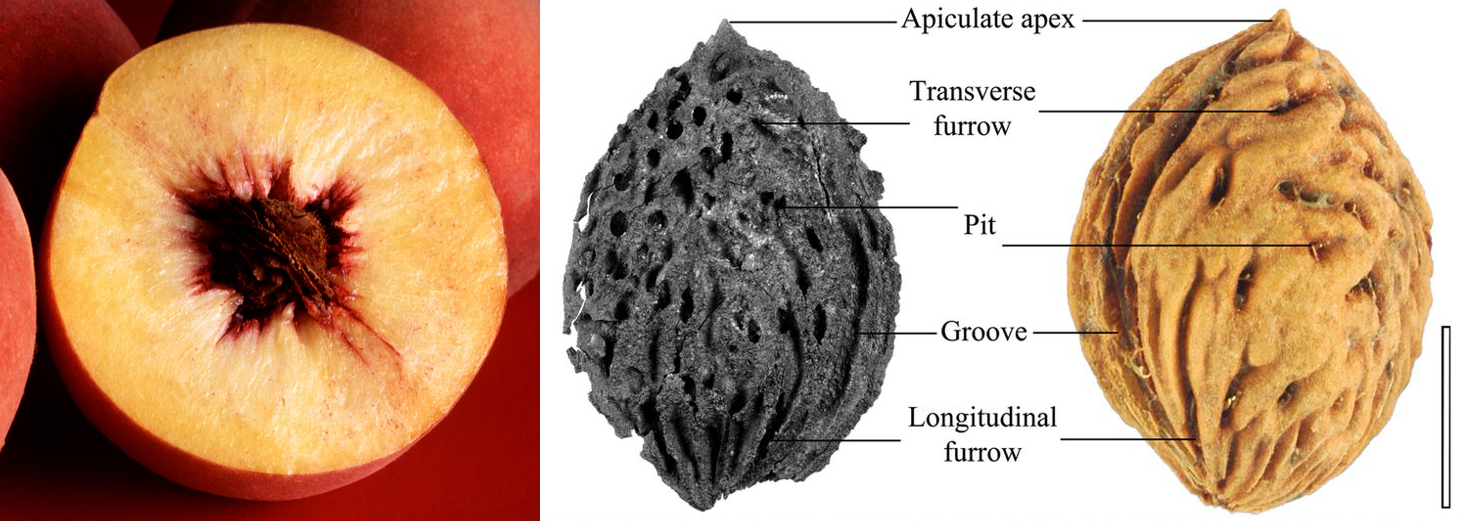
Peaches (drupe and endocarps). Left: A modern peach (Prunus persica), sliced in half to show the fleshy mesocarp surround the hard endocarp of the drupe. Right: Comparison of a fossil (left, Prunus kunmingensis, Pliocene, Ciying Formation, Yunnan Province, China) and modern (right, P. persica) peach pit; scale bar = 1 cm. Credits: Autumn red peaches (Jack Dykinga, USDA, via Wikimedia Commons, Public Domain); fossil and modern peach pits (From fig. 3 in Su et al., 2015, Sci Rep 5: 16794, CC BY 4.0). Images modified from originals.
Selected references & further reading
Note: Free full text is made available by the publisher for items marked with a green asterisk. Items held by the Internet Archive are also available for free.
Academic articles and book chapters
* Kowalski, R. 2008. Contribution to the knowledge of the Middle Miocene flora from Konin Brown Coal Basin (central Poland). Acta Palaeobotanica 48: 277–299. PDF: http://bomax.botany.pl/cgi-bin/pubs/data/article_pdf?id=1719
Manchester, S.R. 1994. Fruits and seeds of the middle Eocene Nut Beds flora, Clarno Formation, Oregon. Palaeontographica Americana 58. Read online at the Internet Archive.
Manchester, S.R., V. Wilde, and M.E. Collinson. 2007. Fossil cashew nuts from the Eocene of Europe: Biogeographic links between Africa and South America. International Journal of Plant Sciences 168: 1199–1206. https://doi.org/10.1086/520728
Stone, D.E. 1993. Juglandaceae. Pp. 348–359 in K. Kubitzki, J.G. Rohwer, and V. Bittrich V., eds., The Families and Genera of Vascular Plants, vol 2. Flowering Plants, Dicotyledons: Magnoliid, Hamamelid and Caryophyllid families. Springer, Berlin, Heidelberg. https://doi.org/10.1007/978-3-662-02899-5_43
* Su, T., P. Wilf, Y. Huang, S. Zhang, and Z. Zhou. 2015. Peaches preceded humans: Fossil evidence from SW China. Scientific Reports 5: 16794. https://doi.org/10.1038/srep16794
Tiffney, B.H. 1994. Re-evaluation of the age of the Brandon Lignite (Vermont, USA) based on plant megafossils. Review of Palaeobotany and Palynology 82: 299–315. https://doi.org/10.1016/0034-6667(94)90081-7
Books & textbooks
Evert R.F., and S.E. Eichhorn. 2013. Raven Biology of Plants, 8th ed. W.H. Freeman and Co., New York, New York.
Harris, J.G., and M.W. Harris. 2001. Plant identification terminology, an illustrated glossary, 2nd. ed. Spring Lake Publishing, Spring Lake, Utah.
Reid, E.M., and M.E.J. Chandler. 1933. The London Clay flora. British Museum, London. Read online at the Internet Archive.
Simpson, B.B., and M.C. Ogorzaly. 2014. Economic botany, plants in our world, 4th ed. McGraw Hill Higher Education, New York, New York.
Simpson, M.G. 2010. Plant Systematics, 2nd ed. Academic Press, Burlington, Massachusetts.
Websites
* Armstrong, W.P. 2002–2017. Wayne's Word: Identification of major fruit types. https://www2.palomar.edu/users/warmstrong/fruitid1.htm
* New York Botanical Garden [NYBG] Steere Herbarium Glossary for Vascular Plants: http://sweetgum.nybg.org/science/glossary/
* Spjut, R.W. 2003–2015. A systematic treatment of fruit types. [Note that this classification uses the term "multiple" for fruits here called aggregates, and the term "compound" for fruits here called multiples. Also, this resource is very technical, so is best for advanced users.] Website: http://www.worldbotanical.com/fruit_types.htm#considerations
Content usage
Usage of text and images created for DEAL: Text on this page was written by Elizabeth J. Hermsen. Original written content created by E.J. Hermsen for the Digital Encyclopedia of Ancient Life that appears on this page is licensed under a Creative Commons Attribution-NonCommercial-ShareAlike 4.0 International License. Original images and diagrams created by E.J. Hermsen or J.R. Hendricks are also licensed under Creative Commons Attribution-NonCommercial-ShareAlike 4.0 International License.
Content sourced from other websites: Attribution, source webpage, and licensing information or terms of use are indicated for images sourced from other websites in the figure caption below the relevant image. See original sources for further details. Attribution and source webpage are indicated for embedded videos. See original sources for terms of use. Reproduction of an image or video on this page does not imply endorsement by the author, creator, source website, publisher, and/or copyright holder.
Adapted images. Images that have been adapted or remixed for DEAL (e.g., labelled images, multipanel figures) are governed by the terms of the original image license(s) covering attribution, general reuse, and commercial reuse. DEAL places no further restrictions above or beyond those of the original creator(s) and/or copyright holder(s) on adapted images, although we ask that you credit DEAL if reusing an adapted image from the DEAL website. Please note that some DEAL figures may only be reused with permission of the creator(s) or copyright holder(s) of the original images. Consult the individual image credits for further details.
First released 19 September 2019; last updated 17 August 2021.



